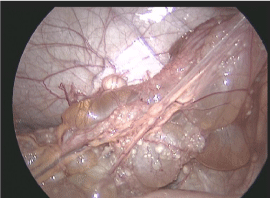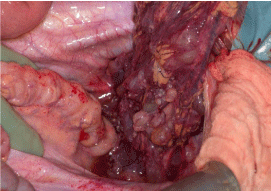Clinical Image
Benign Multicystic Peritoneal Mesothelioma
Laura Toussaint1, Daniel Clerc1,2, Stéphane Yerly3, Nicolas Demartines2, Martin Hübner2* and Olivier Pittet1
1Department of Surgery, Hôpital Riviera-Chablais, Switzerland
2Department of Visceral Surgery, University Hospital of Lausanne, Switzerland
3Department of Histocytopathology, Hôpital du Valais, Switzerland
*Corresponding author: Martin Hübner, Department of Visceral Surgery, University Hospital CHUV, Rue du Bugnon 46, 1011 Lausanne, Switzerland
Published: 12 Dec, 2016
Cite this article as: Toussaint L, Clerc D, Yerly S,
Demartines N, Hübner M, Pittet
O. Benign Multicystic Peritoneal
Mesothelioma. Clin Surg. 2016; 1:
1246.
Clinical Image
A 16-year-old young man without prior medical history presented to the emergency department
complaining of lower abdominal pain and a 20 lbs weight loss since the onset of symptoms 3 months
ago. Clinical examination and blood samples were unremarkable. Ultrasonography and computed
tomography scan of the abdomen revealed free abdominal fluid. An exploratory laparoscopy
showed multiple peritoneal cystic lesions in the pelvis and omentum (Figure 1). Pathology was
consistent with benign multicystic peritoneal mesothelioma (BMPM). Patient underwent complete
cytoreductive surgery (CC-0) in association with hyperthermic intraperitoneal chemotherapy
(HIPEC: cisplatin 50mg/m2 and doxorubicin 15 mg/m2) (Figure 2). Postoperative course was
uneventful and patient showed no signs of recurrence after 9 months.
BMPM is a rare primary tumor of the peritoneum. Etiology remains unknown [1]. The disease
affects predominantly reproductive females with a mean onset at 40 years [2-3]. Symptoms are
mostly unspecific, and exploratory laparoscopy with biopsies are typically required to establish the
diagnosis. BMPM is considered a benign disease with very low malignant potential [3-5]. Therefore,
treatment aims at symptom control and preventing local recurrence. Recurrence is more frequent
in females [1,6] and patients having incomplete surgery and no intraperitoneal chemotherapy [7].
In this context, complete cytoreductive surgery with HIPEC represents the best treatment option for
patients being fit for major surgery.
Figure 1
Figure 2
References
- Shetty S, Nagaraj H, Prabhakar SP, Rajput A. Benign cystic peritoneal mesothelioma. Int J Res Med Sci. 2014; 2: 762-764.
- Elbouhaddouti H, Bouassria A, Mouaqit O, Benjelloun el B, Ousadden A, Mazaz K, et al. Benign cystic mesothelioma of the peritoneum: a case report and literature review. World J Emerg Surg. 2013; 8: 43.
- Tentes AA, Zorbas G, Pallas N, Fiska A. Multicystic peritoneal mesothelioma. Am J Case Rep. 2012; 13: 262-264.
- Safioleas MC, Constantinos K, Michael S, Konstantinos G, Constantinos S, Alkiviadis K. Benign multicystic peritoneal mesothelioma: a case report and review of the literature. World J Gastroenterol. 2006; 12: 5739-5742.
- Somasundaram S, Khajanchi M, Vaja T, Jajoo B, Dey AK. Benign multicystic peritoneal mesothelioma: a rare tumour of the abdomen. Case Rep Surg. 2015; 2015: 613148.
- Vyas D, Pihl K, Kavuturu S, Vyas A. Mesothelioma as a rapidly developing Giant Abdominal Cyst. World J Surg Oncol. 2012; 10: 277.
- Chua TC, Yan TD, Deraco M, Glehen O, Moran BJ, Sugarbaker PH; Peritoneal Surface Oncology Group. Multi-institutional experience of diffuse intra-abdominal multicystic peritoneal mesothelioma. Br J Surg. 2011; 98: 60-64.


